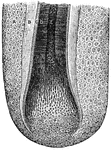
Tree-coral
"These animals are generally called Tree-corals, on account of the forms of the polypidons…
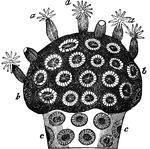
Astrae virdis
"a a, expanded polypes; b b, polypes withdrawn into their cells; c c, coral uncovered by flesh, showing…

Astraea rotulosa
"It is to this family more especially that the formation of the coral reeds is to be attributed. In…

Protozoans
"Their bodies consist either of aa simple elementary cell, with its contents, or of an aggregation of…

Various forms of cells
"A, columnar cells found lining various parts of the intestines (called columnar epthelium);…
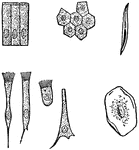
Various kinds of epithelial cells
"A, columnar cells of intestine; B, polyhedral cells of the conjuctiva; C, ciliated conical cells of…

Cross-Section of the Epithelium
"One of the simplest of the tissues in the body is called the epithelium, and its cells are…

Connective Tissue from a Lymphatic Gland
"Consisting of a very fine network of fibrils, around which are cells of various sizes." — Blaisedell,…

Longitudinal section of cartilage
"Showing (1) cartilage with martrix and cells; (2) cartilage with matrix containing cells and white…

Growing yeast cells
Growing Yeast Cells, showing Method of budding and forming Groups of Cells. Each bud appears as a little…
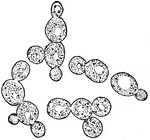
Yeast cells
"Yeast Cells, found in the Juice of Apples, which cause the fermentation of Cider." — Blaisedell,…
!["Hydrozoon is a name given to the great class of the sub-kingdom Cœlenterata, of which hydra is the type. They exhibit a definite histological structure, their tissues having a cellular organization. These tissues are two, an outer or ectoderm, and an inner or endoderm. In most the prey is seized by tentacles surrounding the mouth and furnished with offensive weapons called thread cells, The hydrozoa are all aquatic, and nearly all marine. Their distribution is world-wide. [Pictured] Hydra fusca, with a young bud at b, and a more advanced bud at c."—(Charles Leonard-Stuart, 1911)](https://etc.usf.edu/clipart/15400/15469/hydrozoon_15469_mth.gif)
Hydrozoon
"Hydrozoon is a name given to the great class of the sub-kingdom Cœlenterata, of which hydra is…

Cross-section of a human hair
"Cross-section of One Half of a Human Hair. A hair is made up of horny cells of the outer layer of the…

Sweat gland
"The convoluted gland is seen surrounded by fat cells and may be traced through the true skin to its…
Nerve Cells
"Nerve tissue is really made up of a great number of distinctive units called nerve cells.…
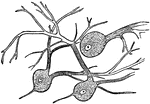
Nerve Cells of the Brain
"Wherever nerve cells are abundant, the nerve tissue has a gray color; in other places, it looks white.…
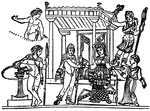
Iphegnia delivers letter to Pylades
"What in this letter is contained, what here, Is written, all I will repeat to thee, That thou mayst…
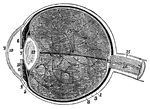
Human Eye
1, the sclerotic thicker behind than in front; 2, the cornea; 3, the choriod; 6, the iris; 7, the pupil;…

Eyebright
A genus of plants of natural order Scropulariaceæ. having a tubular calyx, the upper lip of the…
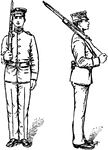
Right Shoulder, Arms
"Without changing the grasp of the right hand, place the piece on the right shoulder, barrel up and…
Left Shoulder, Arms
"Carry the piece with the right hand and place it on the left shoulder, barrel up, trigger guard in…

Bayonet
"The bayonet is a cutting and thrusting weapon consisting of three principal parts, viz, the blade,…
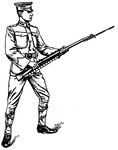
Bayonet Guard
"At the second command sake the position of guard; at the same time throw the rifle smartly to the front,…

Lunge
"Executed in the same manner as the thrust, except that the left foot is carried forward about twice…

Butt Strike
"Straighten right arm and right leg vigorously and swing butt of rifle against point of attack, pivoting…
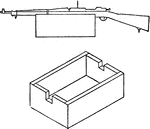
Sighting rest for rifle
"Take an empty pistol ammunition box or a similar well-made box, remove the top and cut notches in the…

Map measurer
"By use of an instrument called a map measurer, set the hand on the face to read zero, roll the small…
Stock, top view
"The parts are the butt, A; small, B; magazine well, C; barrel bed, D; air chamber, E, which reduces…
Stock, right side view
"The parts are the butt, A; small, B; magazine well, C; barrel bed, D; air chamber, E, which reduces…

Lymphatic Vessels in the Fingers
"Among the cells of the body there is, besides the blood capillaries, a system of fine, thin-walled…
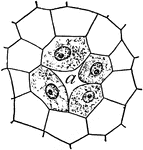
Resin gland of a fir
"Young resin gland of fir: a, duct, an intercellular space formed by the separation of the…
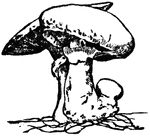
Toad-stool
"Many cells, but without differentiation into stem and leaf; growing horizontally in spreading shoots…

Swing Stage Safety Stirrup
This metal stirrup and guard-rail device which is designed to take the place of rope stirrups. Built…
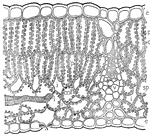
Epidermis
This illustration shows a stem of a plant. e; epidermis; s, stoma; p, palisade mesophyll; ch, chloroplast;…
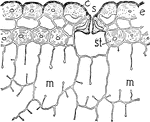
Pine Leaf
This image shows the cross-section of the outer cells of a leaf of pine. S, stoma; E, epidermis; C,…
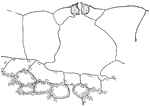
Tradescantia
This illustration shows a close up of the plant tradescantia. It shows the delicate character of the…
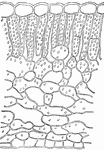
Spathyema
This illustration shows a section of the leaf of skunk cabbage, Spathyema. Note the poorly developed…

Corn Stem
This illustration shows the cross-section of a single vascular bundle of corn stem: ph, phloem; x, small…
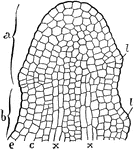
Growing Stem
This illustration shows the longitudinal section of the tip of a growing stem: e, epidermis extending…
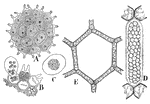
Green Algae
This illustration shows the colonial forms of unicellular green algae: A, Pediastrum, the plants of…
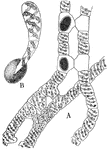
Spirogyra
This illustration shows the sexual reproduction of Spirogyra: A, in lower portion of figure formation…
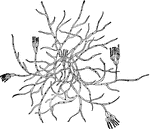
Mold
The green mold, Penicillium, one of the most common of the Sac Fungi. The hyphae of the branching mycelium…
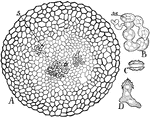
Ascocarp
This illustration shows further development of the ascocarp: A, sectional view, showing the branches,…

Ricciocarpus
This illustration shows the structure of the thallus of Ricciocarpus: A, section of the thallus, showing…
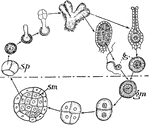
Ricciocarpus
This illustration shows a diagram of the life history of Ricciocarpus. The upper portion of the figure…
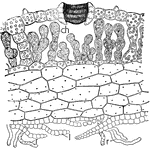
Marchantia
This illustration shows a section through the center of the thallus of Marchantia, showing one of the…
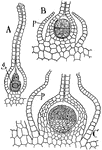
Gametospore
This illustration shows the germination of the gametospore: A, section of a mature archegonium with…

Funaria
This illustration shows the structure of capsule of Funaria: 5, capsule with calyptra, 5A, removed.…
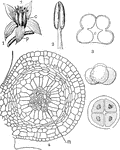
Angiosperm
This illustration shows the flower and sporophylls of Angiosperms: 1, flower of Sedum with leaf-like…

Lepidium
This illustration shows stages in the germination of the gametospore of Lepidium, sectional view: A,…
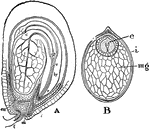
Dicotylendonous
This illustration shows the structure of dicotyledonous seeds: A, nearly mature seed of Lepidium. The…
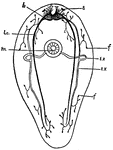
Turbellarian
This is a diagram of a Turbellarian, showing the general arrangement of the nervous structures and one…

Turbellarian
This is a diagram of transverse section of a Turbellarian through the region of the mouth. d.m., dermo-muscular…

Rotifer
This diagram shows a sagittal section of a Rotifer. b, brain; bl., excretory bladder; c, cloaca, the…

Annelid
This diagram shows the longitudinal section of the anterior end of the annelid. A, sagittal section;…
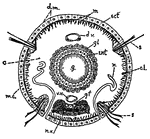
Annelid
This diagram shows a transverse section of dero. c., caelom; c.l., cells of the so-called "lateral line";…

